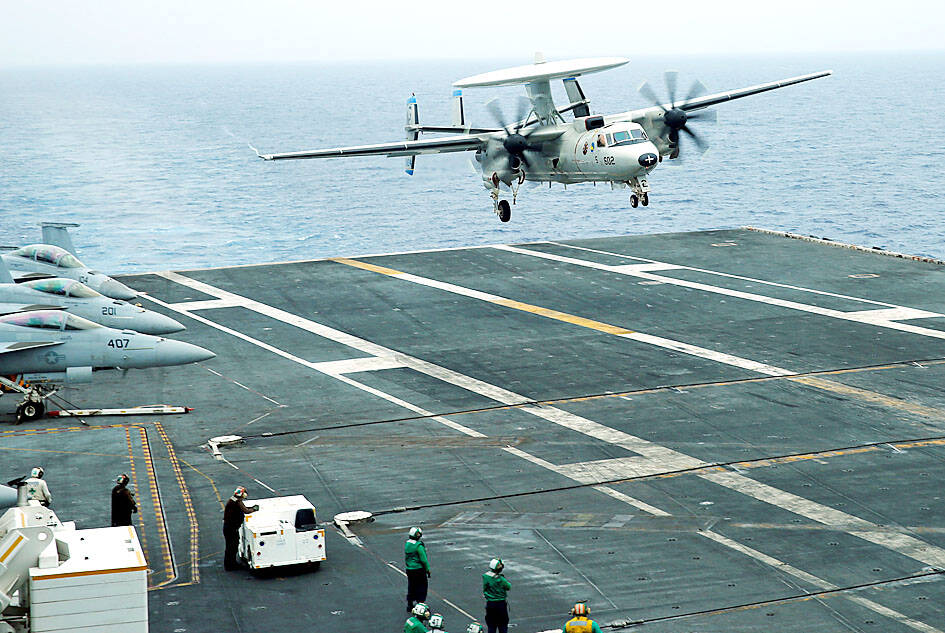The air force must replace its fleet of Northrop Grumman E-2K Hawkeye airborne early warning and control systems (AWACS) with the E-2D variant in the face of increased Chinese incursions into areas east of Taiwan, a source said yesterday.
The military plans to buy six E-2Ds — the most advanced Hawkeye variant that the US Navy uses — to replace the five operational aircraft in its inventory, the source said on condition of anonymity.
On Jan. 17, the Legislative Yuan suspended NT$90 billion (US$2.73 billion) of the Executive Yuan’s proposed defense budget and slashed another NT$8.4 billion as part of a historic 6.6 percent cut to the general budget.

Photo: Reuters
The air force has long eyed the E-2D Advanced Hawkeye and asked Washington twice for their sale, the source said.
The first request was rejected due to its perceived redundancy with land-based radar, the source said.
The Chinese People’s Liberation Army’s activities to the east of Taiwan and its development of stealth aircraft have underscored the importance of advanced, over-the-horizon capability offered by the E-2D platform, the source said.
This year represents a special opportunity for Taiwan to obtain the E-2D, as assembly lines have been activated to fulfill a Japanese contract for the same system, the source said.
The military’s plan to obtain the radar planes was based on “clear operational need and in no way wastes public funds,” they said.
In 1995, the air force received four E-2T aircraft that entered into service the same year. In 2013, they were upgraded to the E-2K standard.
The air force bought two new E-2K aircraft in 1999, which entered service in 2005.
However, one was seriously damaged in November 2022 when it skidded off the runway at a Pingtung County air base after its landing gear was not deployed because of pilot error.
The E-2D features an active electronically scanned array radar and sensor fusion, enabling superior multiple-target detection and tracking capabilities compared with the E-2K, which uses an analog radar, publicly available sources showed.
Separately, the Ministry of National Defense yesterday declined to comment on reports that it plans to buy Sikorsky MH-60R anti-submarine warfare helicopters or M109A7 self-propelled howitzers from the US, only saying that Taiwan needs to bolster its national defense.
“The nation’s arms procurement plan aims to meet four goals: build up asymmetric warfare capabilities, strengthen defense resilience, enhance reserve combat’s capabilities and effectively respond to gray zone activities according to the level of threat and progress made in integrating the military services for joint warfare,” a ministry spokesperson said.
The stability and predictability of the defense budget is of key importance to maintaining the military’s ability to defend the nation, they added.

TRAGEDY STRIKES TAIPEI: The suspect died after falling off a building after he threw smoke grenades into Taipei Main Station and went on a killing spree in Zhongshan A 27-year-old suspect allegedly threw smoke grenades in Taipei Main Station and then proceeded to Zhongshan MRT Station in a random killing spree that resulted in the death of the suspect and two other civilians, and seven injured, including one in critical condition, as of press time last night. The suspect, identified as a man surnamed Chang Wen (張文), allegedly began the attack at Taipei Main Station, the Taipei Fire Department said, adding that it received a report at 5:24pm that smoke grenades had been thrown in the station. One man in his 50s was rushed to hospital after a cardiac arrest

A car bomb killed a senior Russian general in southern Moscow yesterday morning, the latest high-profile army figure to be blown up in a blast that came just hours after Russian and Ukrainian delegates held separate talks in Miami on a plan to end the war. Kyiv has not commented on the incident, but Russian investigators said they were probing whether the blast was “linked” to “Ukrainian special forces.” The attack was similar to other assassinations of generals and pro-war figures that have either been claimed, or are widely believed to have been orchestrated, by Ukraine. Russian Lieutenant General Fanil Sarvarov, 56, head

SAFETY FIRST: Double the number of police were deployed at the Taipei Marathon, while other cities released plans to bolster public event safety Authorities across Taiwan have stepped up security measures ahead of Christmas and New Year events, following a knife and smoke bomb attack in Taipei on Friday that left four people dead and 11 injured. In a bid to prevent potential copycat incidents, police deployments have been expanded for large gatherings, transport hubs, and other crowded public spaces, according to official statements from police and city authorities. Taipei Mayor Chiang Wan-an (蔣萬安) said the city has “comprehensively raised security readiness” in crowded areas, increased police deployments with armed officers, and intensified patrols during weekends and nighttime hours. For large-scale events, security checkpoints and explosives

PUBLIC SAFETY: The premier said that security would be tightened in transport hubs, while President Lai commended the public for their bravery The government is to deploy more police, including rapid response units, in crowded public areas to ensure a swift response to any threats, President William Lai (賴清德) said yesterday after a knife attack killed three people and injured 11 in Taipei the previous day. Lai made the remarks following a briefing by the National Police Agency on the progress of the investigation, saying that the attack underscored the importance of cooperation in public security between the central and local governments. The attack unfolded in the early evening on Friday around Taipei Main Station’s M7 exit and later near the Taipei MRT’s Zhongshan